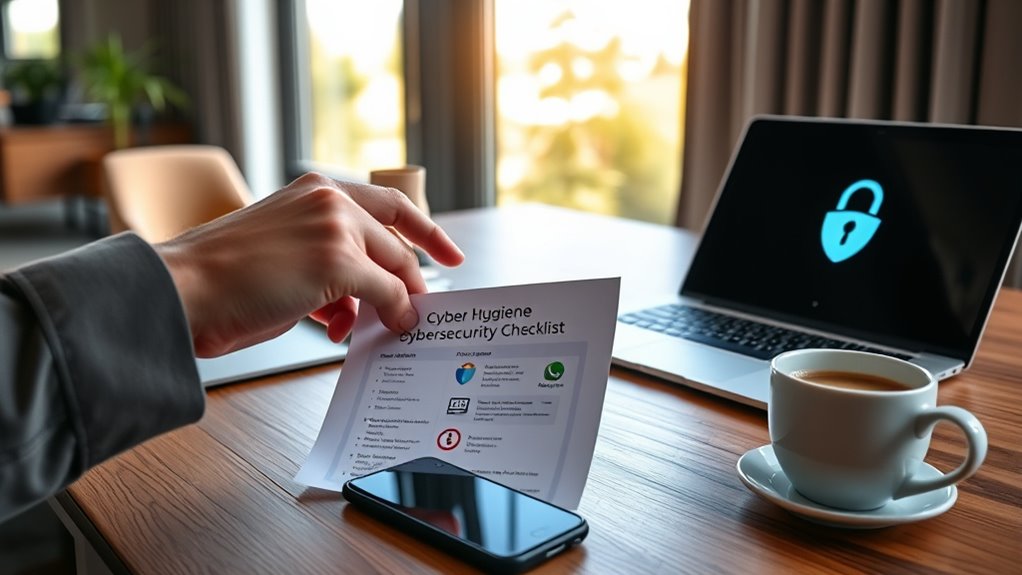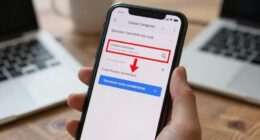To strengthen your cyber hygiene by 9 AM, start by ensuring your passwords are strong, unique, and use passphrases or password managers. Log in with multi-factor authentication whenever possible. Check for software and system updates, scan your devices for threats, and clear any suspicious emails or links. Connect securely with VPNs or trusted networks, back up critical data, follow data-sharing protocols, and report any unusual activity. Keep these habits in mind—more tips will help you stay protected throughout the day.
Key Takeaways
- Verify all passwords are strong, unique, and updated; enable multi-factor authentication on critical accounts.
- Perform quick device and network security checks, including locking devices and avoiding unsecured Wi-Fi.
- Review recent emails for phishing signs; report suspicious messages immediately.
- Ensure software and system updates are installed and sources verified before use.
- Practice daily security habits like locking screens, backing up data, and being alert to potential threats.
Verify Your Passwords Are Strong and Unique
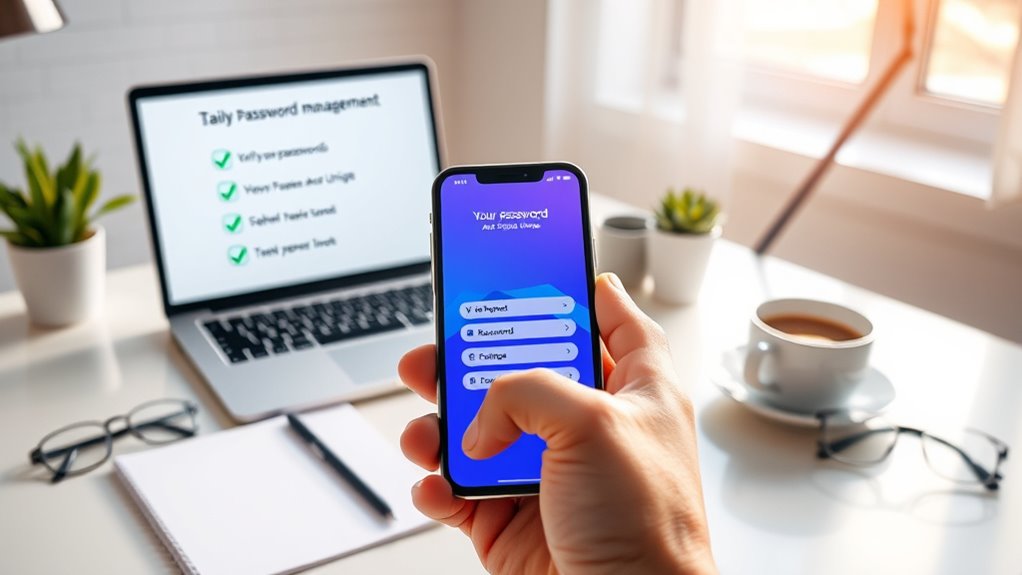
To keep your accounts secure, you need to verify that your passwords are both strong and unique. Aim for at least 16 characters, mixing uppercase and lowercase letters, numbers, and symbols to boost complexity. Avoid common words, personal info, or predictable patterns like “password1” or “12345.” Instead, create passphrases of four to seven unrelated words or use a password manager to generate random, long passwords. Never reuse passwords across different accounts, as this greatly increases your risk if one gets compromised. Regularly test your passwords’ strength with entropy tools and update weak ones immediately. Remember, simple or reused passwords are easy targets for hackers, so prioritize creating unique, complex passwords for each account to stay protected. 80% of data breaches result from weak or stolen passwords, highlighting the importance of maintaining high-quality credentials. Ensuring that your passwords are stored securely and properly managed adds an extra layer of protection against cyber threats.
Log In Using Multi-Factor Authentication
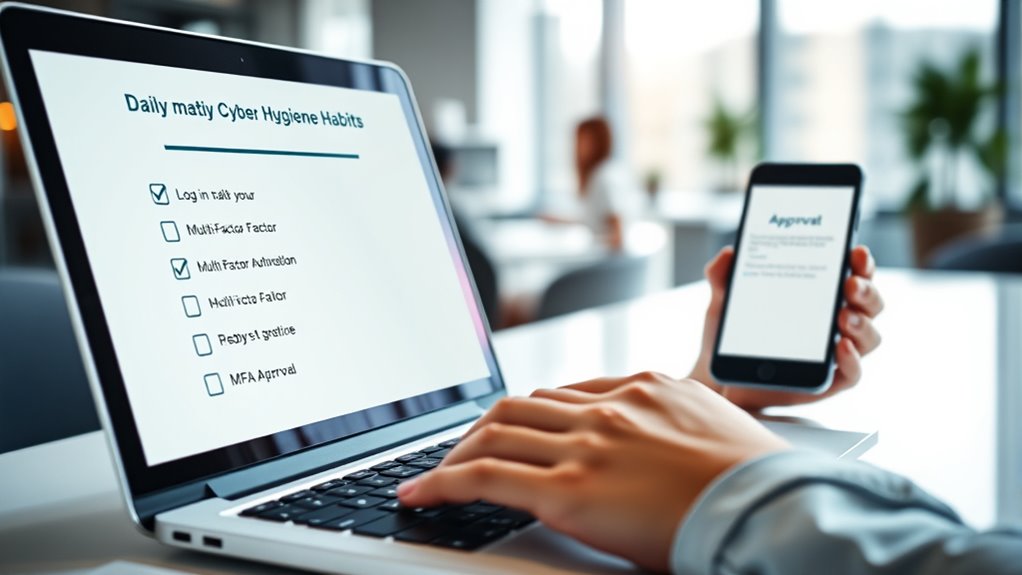
You should enable MFA everywhere to strengthen your account security. Using authenticator apps adds an extra layer beyond passwords, making unauthorized access much harder. Be cautious of MFA bypass methods to guarantee your protection remains effective. Enhanced security measures significantly reduce the risk of unauthorized access even if passwords are compromised. Additionally, staying informed about cybersecurity best practices helps you adapt to new threats and maintain your defenses.
Enable MFA Everywhere
Enabling multi-factor authentication (MFA) across your organization is essential for strengthening security beyond just passwords. It adds an extra layer of protection, preventing credential theft and phishing attacks, especially since employees log into nearly 10 applications daily. Universal MFA deployment maximizes coverage, aligning with zero-trust security models that require continuous verification. Use a variety of MFA methods, such as security keys, biometrics, or app-based codes, and tailor options based on security needs and user convenience. Avoid excessive prompts by implementing adaptive MFA that triggers only during risky sign-ins. Document policies and enforce MFA consistently to meet compliance standards like HIPAA or PCI DSS. Don’t forget to provide backup options for lost devices, ensuring seamless access without compromising security. Incorporating ethical hacking techniques can also help identify potential vulnerabilities in your MFA deployment, strengthening your overall security posture.
Use Authenticator Apps
Have you considered how authenticator apps can bolster your organization’s security? These apps generate time-sensitive codes that serve as a secondary verification step, making it much harder for attackers to access accounts. MFA with authenticator apps can block up to 99.9% of automated attacks and credential stuffing, even if passwords are compromised. They’re especially effective against phishing, as stolen credentials alone won’t grant access without the secondary code. Many organizations rely on these apps to meet compliance standards like GDPR and PCI DSS, reducing legal and financial risks. Authenticator apps are widely supported across various platforms and devices, making integration straightforward for most organizations. These apps also help organizations establish strong security protocols that adapt to emerging cyber threats. Authenticator apps are flexible and can be integrated with single sign-on systems, allowing tailored security policies based on user roles or data sensitivity. Adopting these apps today ensures stronger, more resilient defenses against evolving cyber threats.
Avoid MFA Bypass
To effectively prevent MFA bypass attempts, organizations must implement robust security measures that address common attack methods like man-in-the-middle (MiTM) and adversary-in-the-middle (AiTM) attacks. These threats exploit vulnerabilities such as intercepting authentication data or tricking users into approving malicious requests. Using strong, modern MFA methods, like WebAuthn, substantially reduces these risks. To help you understand, here’s a quick comparison:
| Threat | Mitigation |
|---|---|
| AiTM Attacks | Use WebAuthn and behavioral analysis |
| MiTM Attacks | Enforce HTTPS and secure device setups |
| MFA Fatigue | Limit verification prompts |
| SIM Swapping | Use app-based authenticators |
| Phishing | Conduct regular training |
Stay vigilant, update security tools, and promote secure habits to keep MFA effective. Incorporating cybersecurity best practices can further strengthen your defenses against sophisticated threats.
Check for Software and System Updates
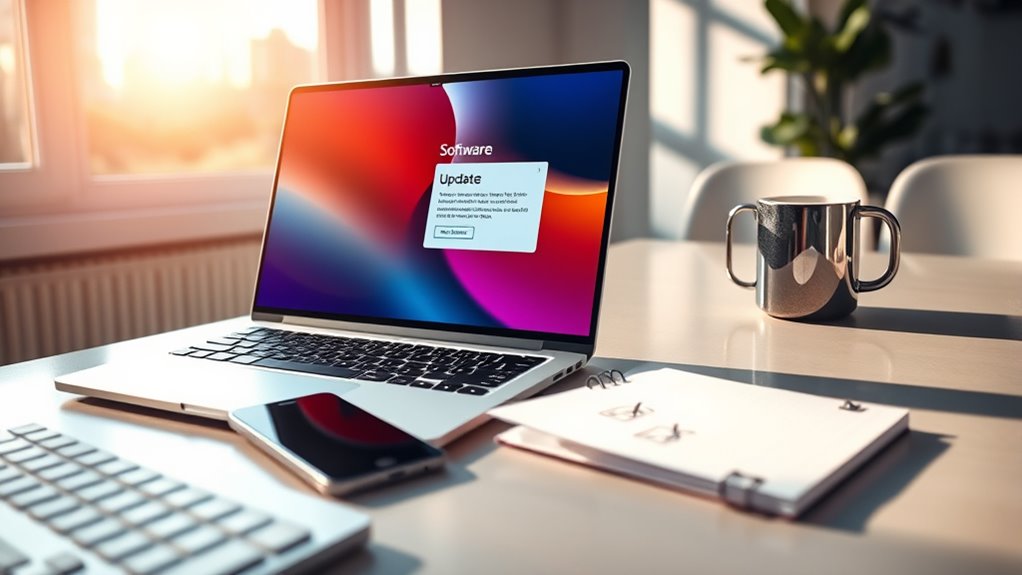
You should enable automatic updates on all your systems and software to ensure security patches are applied promptly. It’s vital to verify that updates come from trusted sources to avoid malware or phishing risks. Additionally, scheduling regular checks helps you stay current and reduces vulnerabilities over time. Regularly reviewing system update protocols can help maintain security standards and prevent overlooked vulnerabilities. Implementing a centralized management tool can streamline this process and enhance overall security.
Enable Automatic Updates
Enabling automatic updates guarantees that your software and systems receive the latest security patches and performance improvements without manual effort. This minimizes vulnerabilities by ensuring security fixes are installed promptly, reducing the window for cyberattacks. It also keeps critical applications like your operating system and antivirus software protected against new threats. Automatic updates support business continuity by decreasing downtime caused by malware or outdated software issues. They eliminate human error and delays that can leave systems exposed. Once enabled, updates are pushed automatically, requiring no ongoing intervention—though periodic checks are recommended to confirm functionality. Be aware that some updates may need system restarts, so plan accordingly. Regularly review your settings to ensure automatic updates remain active and functioning correctly. Additionally, automatic updates help prevent system incompatibilities by ensuring your software remains compatible with the latest hardware and application standards.
Verify Software Sources
Verifying software sources is a crucial step in maintaining cybersecurity, as downloading from untrusted or unofficial sites can introduce malware or compromised files into your systems. Always download software from official app stores or vendor websites, which are more likely to provide unaltered, malware-free files. Before downloading, check the domain and guarantee an active SSL certificate to prevent phishing or spoofing. Your organization’s policies should mandate using only approved, vetted sources, and never bypass IT-approved channels. Enforce code signing and verification, guaranteeing all software is digitally signed by trusted authorities. Regularly audit your software inventory to detect unauthorized or outdated applications. Implementing robust source verification processes is essential to prevent supply chain attacks and ensure software integrity. By verifying sources consistently, you reduce the risk of malware infections and maintain the integrity of your systems.
Schedule Regular Checks
Scheduling regular checks for software and system updates is essential to maintaining security and operational stability. You should plan updates during off-peak hours like nights or weekends to minimize disruptions and give your team time to troubleshoot if issues arise. Having a clear update schedule allows better communication and resource allocation across teams. Make sure to maintain a calendar of upcoming updates to keep everyone informed. Enable automatic updates where possible, especially for critical patches, to ensure vulnerabilities are promptly addressed. Conduct pre-update assessments to verify compatibility and prevent failures, and regularly review your software inventory to remove unsupported or end-of-life applications. Consistent scheduling keeps your systems current, reduces security risks, and maintains business continuity.
Scan Your Devices for Security Threats
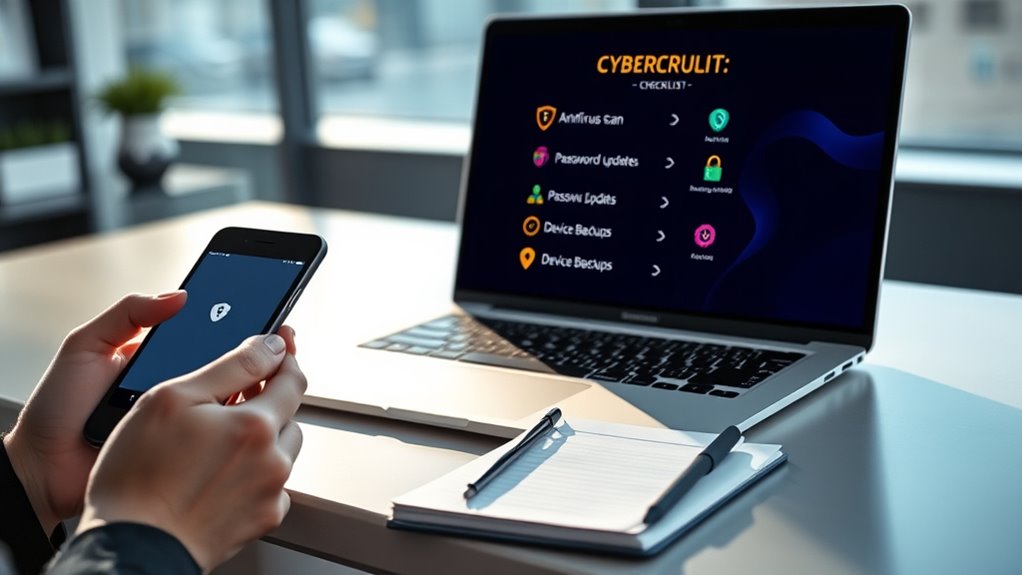
Regularly scanning your devices for security threats is essential to maintaining a strong defense against cyberattacks. Use automated tools like Microsoft Defender Antivirus to perform weekly or bi-weekly scans, especially for critical systems. These tools improve accuracy by leveraging features such as file hash computation and trusted image identifiers, reducing human error. Always configure exhaustive scan policies based on device type and role to ensure thorough coverage. Focus on identifying vulnerabilities like SQL injections or cross-site scripting, especially in high-risk systems. Follow best practices by scheduling full scans after installing new software or updates, managing CPU throttling, and inspecting content types to catch spoofed files. Regular scans, combined with continuous monitoring, help you stay ahead of emerging threats and strengthen your overall security posture. Vulnerability scanning is a key component of proactive security management, allowing organizations to identify and remediate issues before they can be exploited by attackers. Incorporating security awareness into your routine can help users recognize and prevent potential threats effectively.
Review and Clear Suspicious Emails or Links
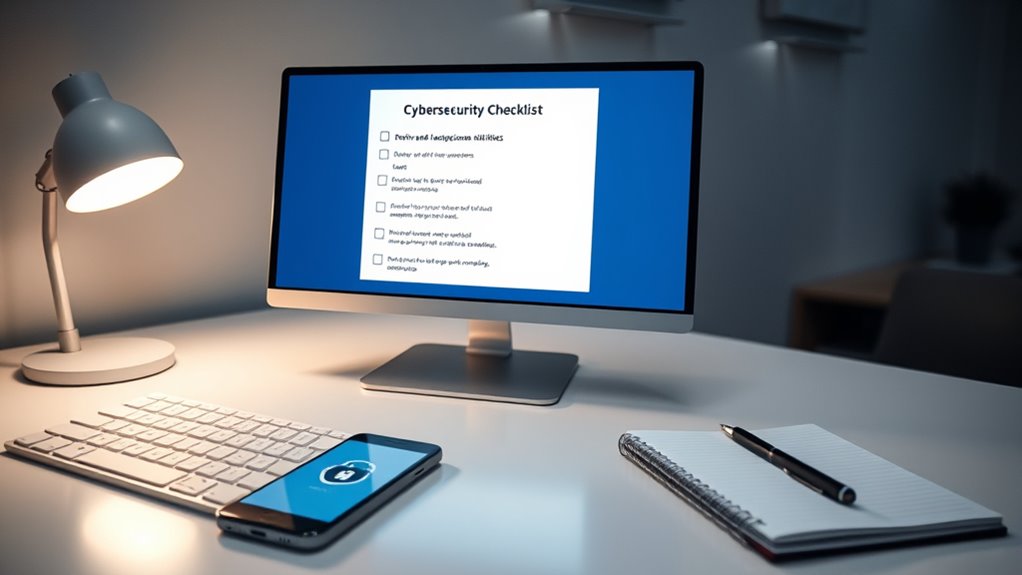
Because phishing emails are a common attack vector, it’s crucial to scrutinize every suspicious message carefully before taking any action. Look for generic greetings instead of personalized ones, and check for spelling errors or grammatical mistakes, which often signal fraud. Be wary of urgent or threatening language that pressures you to act quickly. Always examine embedded links by hovering over them to reveal their true destination—malicious sites often disguise themselves with subtle URL differences. Avoid opening unexpected attachments unless you’ve verified their safety through a secondary channel. If you suspect an email, report it immediately to your IT or security team. Regularly practicing this review process considerably reduces your risk of falling victim to phishing scams and helps protect sensitive company data. Research shows that phishing attacks have surged by over 4,151% since 2022, highlighting the importance of vigilant email review.
Ensure Your Device Is Locked When Away
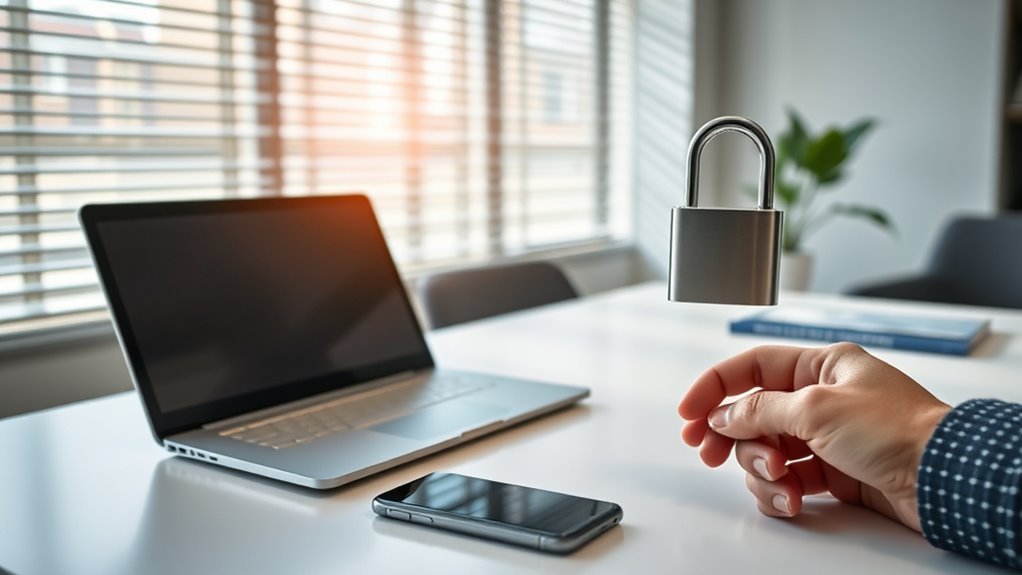
Leaving your device unfastened when you’re away creates a significant security risk, as unauthorized individuals could access sensitive data or systems. Always lock your screen whenever you step away, even briefly, to prevent unauthorized use. Configure your device to auto-lock within five minutes or less of inactivity, offering an extra layer of protection. Use a strong PIN, password, or biometrics like fingerprint or facial recognition to secure your device. Avoid bypassing security measures through jailbreaking or rooting, which weaken defenses. Regularly test and update your lock settings to stay protected against new vulnerabilities. Remember, a locked device prevents physical access attacks, safeguards your credentials, and helps comply with company policies. Locking your device is a simple yet effective way to prevent unauthorized access. Make locking your device a non-negotiable habit for better security every day.
Connect to Secure Networks or Use VPNs
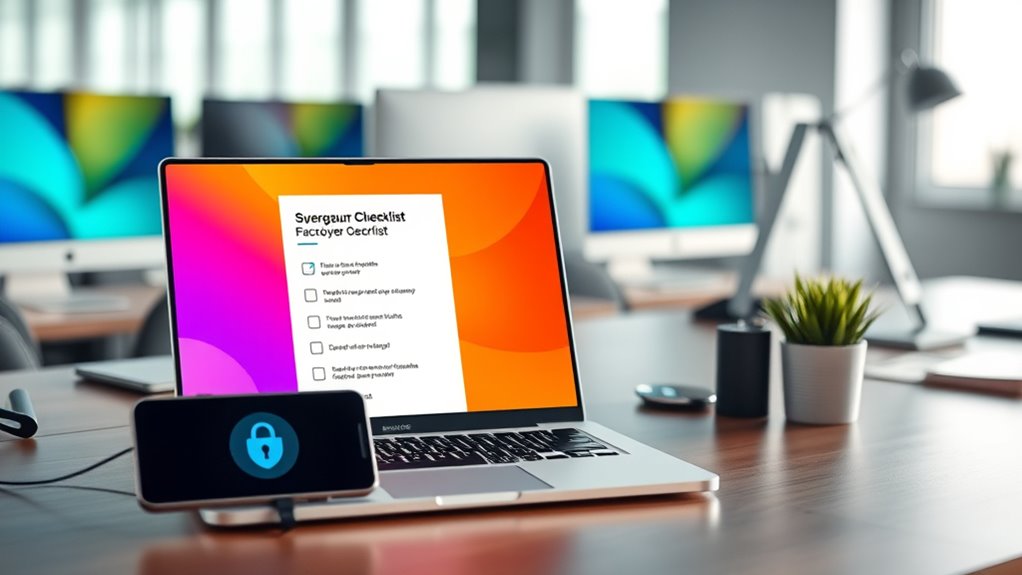
Always verify that you’re connecting to authentic, secure networks to prevent unauthorized access. When working on untrusted or public Wi-Fi, enable your VPN to encrypt data and protect sensitive information. Avoid using public Wi-Fi networks without a VPN, as they substantially increase your risk of cyber threats. A VPN creates a secure, encrypted tunnel for data transmission, safeguarding your information from potential eavesdroppers on insecure networks. Additionally, understanding cyber hygiene best practices can further enhance your security posture.
Verify Network Authenticity
How can you guarantee your connection is secure before sharing sensitive information? First, verify the network’s authenticity by confirming the network name and security type with your IT department or trusted sources. Avoid open or public Wi-Fi networks that lack proper authentication, as they’re vulnerable to man-in-the-middle attacks. Look for digital certificates or security keys that prove the network’s legitimacy, especially for enterprise connections. Disable automatic connections to unfamiliar networks in your device settings. Use built-in security tools or authentication apps that flag unverified networks. Rely on protocols like 802.1X or certificate-based authentication to ensure the network is legitimate. These steps help prevent credential theft, malware infection, and unauthorized access, keeping your data safe before you connect. Additionally, verifying the network’s encryption standards can provide an extra layer of protection.
Enable VPN Connections
Once you’ve verified that you’re connecting to a legitimate network, adding a VPN can further bolster your security. A VPN creates an encrypted tunnel between your device and the company’s network, preventing unauthorized access and data interception. It reduces the risk of breaches and cyberattacks by protecting sensitive information, like emails and files, from eavesdroppers. VPNs are especially valuable for remote workers or employees on the move, as they secure connections no matter where you are. They also help protect customer data, boosting trust and compliance. VPNs are a cost-effective security option, simplifying management by consolidating protection under a single license. Using a VPN ensures your data stays private and safe, even over unsecured networks, giving you peace of mind during daily work activities. VPNs block ISP logging and surveillance, providing an additional layer of privacy. Additionally, implementing cyber hygiene best practices can significantly enhance your overall security posture.
Avoid Public Wi-Fi
Public Wi-Fi networks are inherently risky because they often lack proper security measures, making it easy for hackers to intercept your data or spread malware. Connecting to unsecured networks exposes you to data theft, malware distribution, session hijacking, and phishing attacks. Nearly two out of five people use public Wi-Fi daily, and a quarter have experienced security issues from it. To stay safe, you should:
- Use trusted, secure networks whenever possible
- Avoid performing sensitive tasks like banking on public Wi-Fi
- Verify the legitimacy of the network before connecting
- Keep your devices updated with the latest security patches
- Many public Wi-Fi networks lack encryption, which means your data can be easily accessed by malicious actors.
Backup Critical Data Before Starting Work
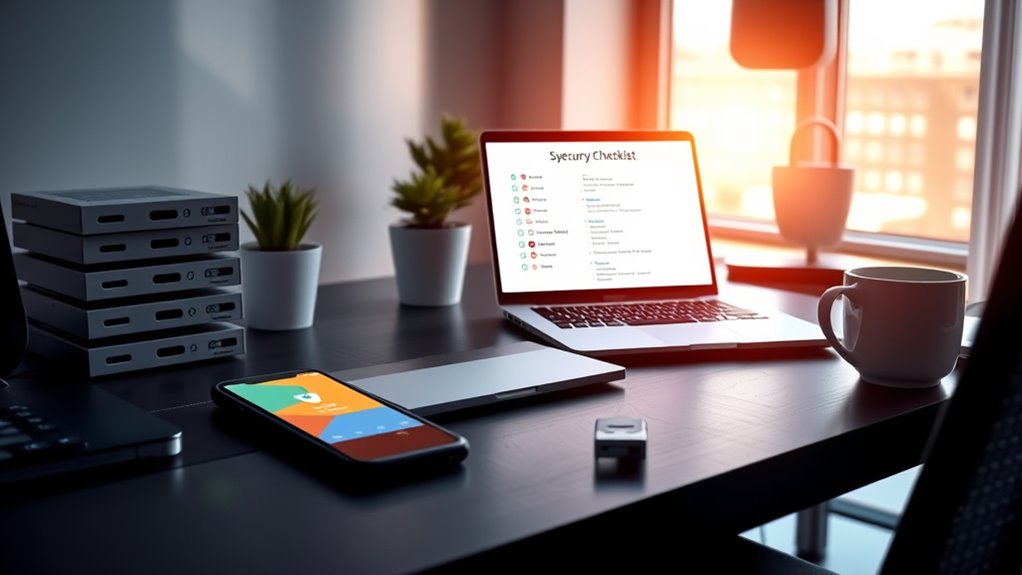
Starting your workday by backing up critical data is essential to maintaining cybersecurity hygiene. Only about 10% of users back up daily, leaving most vulnerable to permanent data loss. Regular backups, ideally daily, minimize data gaps and help businesses recover faster after cyberattacks or outages. Use automated tools to schedule backups early in the morning, ensuring no critical files are missed. Before starting work, close all active files and applications to ensure complete data capture. Incorporate off-site or cloud backups for added protection against disasters. Verify and test your backup restoration process regularly—at least weekly—to confirm data integrity. Encrypt backups and control access to safeguard sensitive information. Making backup routines part of your morning habits strengthens your organization’s data resilience and business continuity. Implementing proper backup hygiene reduces the risk of human error and enhances overall security posture.
Follow Data Handling and Sharing Protocols
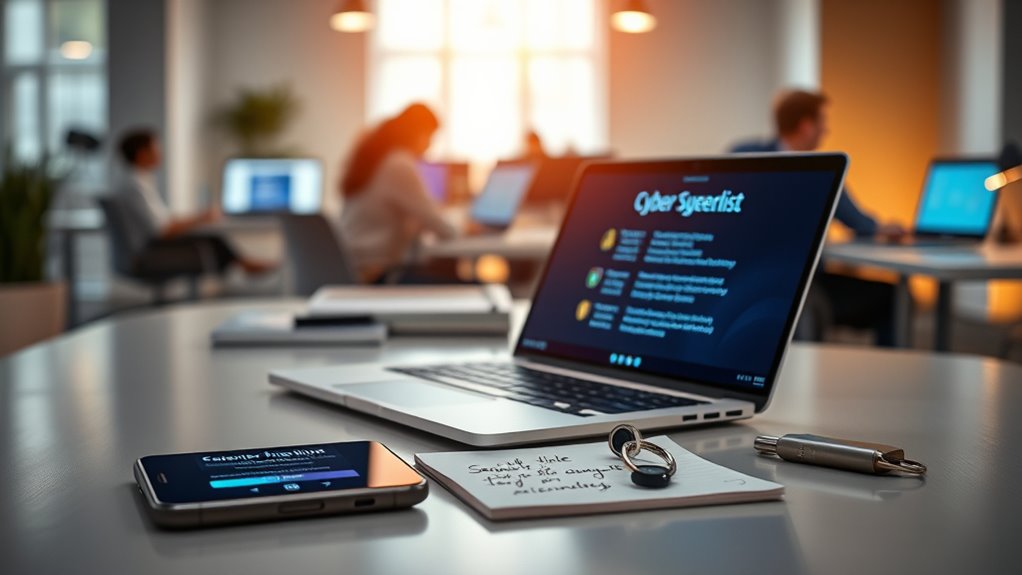
Implementing proper data handling and sharing protocols helps protect your organization from data breaches and compliance issues. You should always use encrypted transfer protocols like SFTP or HTTPS to safeguard data in transit. Enable multi-factor authentication (MFA) for all access points to strengthen identity verification. Apply end-to-end encryption to keep data confidential throughout the sharing process, including storage. Additionally, enable detailed logging and auditing to track all file access and transfers, creating a clear trail for investigations. Regularly update encryption algorithms and security protocols to stay ahead of emerging threats. Remember to:
Implement strong data protocols with encryption, MFA, and detailed audits to prevent breaches and ensure compliance.
- Perform automated data discovery and classification
- Enforce access controls based on data sensitivity
- Use role-based or attribute-based access models
- Apply masking or anonymization for PII data
Report Any Suspicious Activity or Security Concerns

Encouraging a culture where employees feel comfortable reporting suspicious activity is essential for early threat detection. When you know it’s safe to speak up, you’re more likely to report unusual emails, system glitches, or strange behaviors without fear of blame. Promoting a non-punitive environment and rewarding proactive reporting foster transparency, making it easier to identify threats early. Clear policies define what constitutes suspicious activity, like unauthorized access or malware infections, and specify reporting timelines. Open communication channels and anonymous reporting options remove barriers, encouraging more reports. Regular training on how and when to report, combined with effective feedback loops, keeps everyone vigilant. By taking these steps, you help strengthen your organization’s security defenses and minimize potential damages from cyber threats. Building a security-minded environment ensures ongoing vigilance and collective responsibility among all staff.
Frequently Asked Questions
How Often Should I Change My Passwords for Optimal Security?
You ask how often you should change your passwords for ideal security. Experts recommend you only reset passwords if there’s evidence of a breach or suspicious activity, not on a fixed schedule like every 60 or 90 days. Instead, focus on creating long, unique passphrases, use a password manager, and enable multi-factor authentication. Regularly monitor for compromised passwords and avoid reuse to keep your accounts safe.
What Are the Best Practices for Creating Strong, Memorable Passwords?
Imagine forging a key that opens any lock—your goal with strong passwords. Use at least 14-16 characters, mixing uppercase, lowercase, numbers, and symbols. Think of passphrases as your secret code, like unrelated words strung together. Keep each password unique, like different keys for different doors. Use a password manager to remember them all, and avoid common info like birthdays. Mastering these habits keeps your digital fortress secure and memorable.
How Can I Verify the Authenticity of Suspicious Emails?
When you receive a suspicious email, first check the email headers for SPF, DKIM, and DMARC results to confirm authentication. Look for inconsistencies in sender details, unexpected links, or attachments. Verify the sender’s domain and use real-time verification tools if possible. Be cautious of urgent language or errors, and avoid clicking on suspicious links. These steps help you identify phishing attempts and protect your information.
What Should I Do if I Suspect My Device Is Infected?
If you suspect your device is infected, don’t ignore it—think of it as a digital emergency! Immediately disconnect it from all networks to stop malware from spreading. Run a full scan with trusted security software, update your system and apps, and change your passwords. Avoid shutting down abruptly; restart in safe mode if possible. Educate yourself on signs of infection, and consider professional help if issues persist.
When Is the Appropriate Time to Update Device Firmware and Embedded Software?
You should update device firmware and embedded software when critical security vulnerabilities are identified, especially those with high CVSS scores. Schedule updates during off-peak hours to minimize disruption, and always back up data beforehand. Verify compatibility, test updates in controlled environments, and guarantee devices are powered and connected reliably. Coordinate updates carefully, communicate clearly with stakeholders, and monitor devices afterward to catch issues early.
Conclusion
By sticking to these daily habits, you’re building a fortress around your digital life. Think of it as locking every door and window to keep intruders out. Consistency is key—don’t leave any stone unturned. When you stay vigilant and follow this checklist, you’re not just reacting to threats but staying one step ahead. Remember, a chain is only as strong as its weakest link, so make each habit count to keep your data safe and sound.
